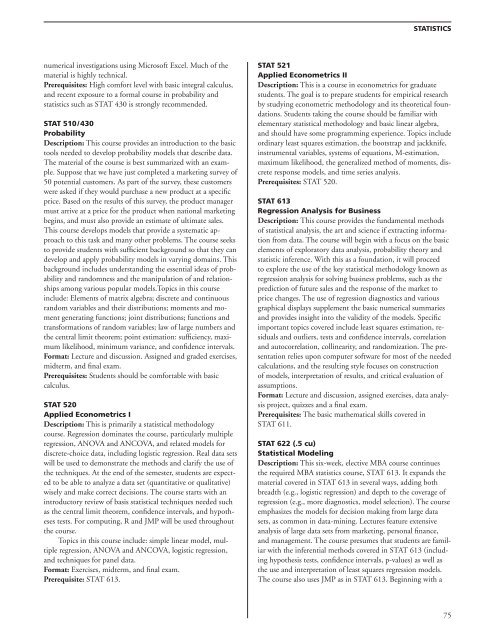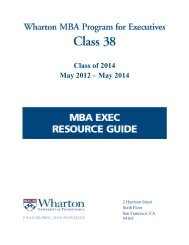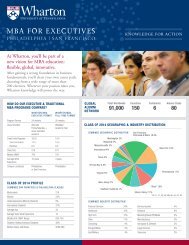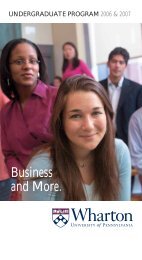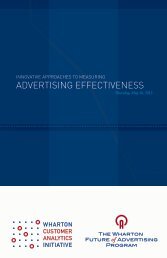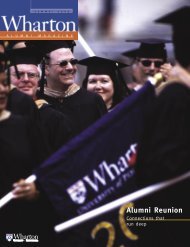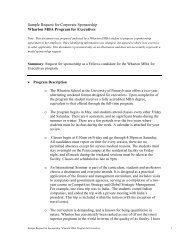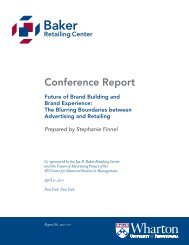Explore Options; Plan Your MBA Academic Program
Explore Options; Plan Your MBA Academic Program
Explore Options; Plan Your MBA Academic Program
You also want an ePaper? Increase the reach of your titles
YUMPU automatically turns print PDFs into web optimized ePapers that Google loves.
numerical investigations using Microsoft Excel. Much of the<br />
material is highly technical.<br />
Prerequisites: High comfort level with basic integral calculus,<br />
and recent exposure to a formal course in probability and<br />
statistics such as STAT 430 is strongly recommended.<br />
STAT 510 / 430<br />
Probability<br />
Description: This course provides an introduction to the basic<br />
tools needed to develop probability models that describe data.<br />
The material of the course is best summarized with an example.<br />
Suppose that we have just completed a marketing survey of<br />
50 potential customers. As part of the survey, these customers<br />
were asked if they would purchase a new product at a specific<br />
price. Based on the results of this survey, the product manager<br />
must arrive at a price for the product when national marketing<br />
begins, and must also provide an estimate of ultimate sales.<br />
This course develops models that provide a systematic approach<br />
to this task and many other problems. The course seeks<br />
to provide students with sufficient background so that they can<br />
develop and apply probability models in varying domains. This<br />
background includes understanding the essential ideas of probability<br />
and randomness and the manipulation of and relationships<br />
among various popular models.Topics in this course<br />
include: Elements of matrix algebra; discrete and continuous<br />
random variables and their distributions; moments and moment<br />
generating functions; joint distributions; functions and<br />
transformations of random variables; law of large numbers and<br />
the central limit theorem; point estimation: sufficiency, maximum<br />
likelihood, minimum variance, and confidence intervals.<br />
Format: Lecture and discussion. Assigned and graded exercises,<br />
midterm, and final exam.<br />
Prerequisites: Students should be comfortable with basic<br />
calculus.<br />
STAT 520<br />
Applied Econometrics I<br />
Description: This is primarily a statistical methodology<br />
course. Regression dominates the course, particularly multiple<br />
regression, ANOVA and ANCOVA, and related models for<br />
discrete-choice data, including logistic regression. Real data sets<br />
will be used to demonstrate the methods and clarify the use of<br />
the techniques. At the end of the semester, students are expected<br />
to be able to analyze a data set (quantitative or qualitative)<br />
wisely and make correct decisions. The course starts with an<br />
introductory review of basis statistical techniques needed such<br />
as the central limit theorem, confidence intervals, and hypotheses<br />
tests. For computing, R and JMP will be used throughout<br />
the course.<br />
Topics in this course include: simple linear model, multiple<br />
regression, ANOVA and ANCOVA, logistic regression,<br />
and techniques for panel data.<br />
Format: Exercises, midterm, and final exam.<br />
Prerequisite: STAT 613.<br />
STATISTICS<br />
STAT 521<br />
Applied Econometrics II<br />
Description: This is a course in econometrics for graduate<br />
students. The goal is to prepare students for empirical research<br />
by studying econometric methodology and its theoretical foundations.<br />
Students taking the course should be familiar with<br />
elementary statistical methodology and basic linear algebra,<br />
and should have some programming experience. Topics include<br />
ordinary least squares estimation, the bootstrap and jackknife,<br />
instrumental variables, systems of equations, M-estimation,<br />
maximum likelihood, the generalized method of moments, discrete<br />
response models, and time series analysis.<br />
Prerequisites: STAT 520.<br />
STAT 613<br />
Regression Analysis for Business<br />
Description: This course provides the fundamental methods<br />
of statistical analysis, the art and science if extracting information<br />
from data. The course will begin with a focus on the basic<br />
elements of exploratory data analysis, probability theory and<br />
statistic inference. With this as a foundation, it will proceed<br />
to explore the use of the key statistical methodology known as<br />
regression analysis for solving business problems, such as the<br />
prediction of future sales and the response of the market to<br />
price changes. The use of regression diagnostics and various<br />
graphical displays supplement the basic numerical summaries<br />
and provides insight into the validity of the models. Specific<br />
important topics covered include least squares estimation, residuals<br />
and outliers, tests and confidence intervals, correlation<br />
and autocorrelation, collinearity, and randomization. The presentation<br />
relies upon computer software for most of the needed<br />
calculations, and the resulting style focuses on construction<br />
of models, interpretation of results, and critical evaluation of<br />
assumptions.<br />
Format: Lecture and discussion, assigned exercises, data analysis<br />
project, quizzes and a final exam.<br />
Prerequisites: The basic mathematical skills covered in<br />
STAT 611.<br />
STAT 622 (.5 cu)<br />
Statistical Modeling<br />
Description: This six-week, elective <strong>MBA</strong> course continues<br />
the required <strong>MBA</strong> statistics course, STAT 613. It expands the<br />
material covered in STAT 613 in several ways, adding both<br />
breadth (e.g., logistic regression) and depth to the coverage of<br />
regression (e.g., more diagnostics, model selection). The course<br />
emphasizes the models for decision making from large data<br />
sets, as common in data-mining. Lectures feature extensive<br />
analysis of large data sets from marketing, personal finance,<br />
and management. The course presumes that students are familiar<br />
with the inferential methods covered in STAT 613 (including<br />
hypothesis tests, confidence intervals, p-values) as well as<br />
the use and interpretation of least squares regression models.<br />
The course also uses JMP as in STAT 613. Beginning with a<br />
75


